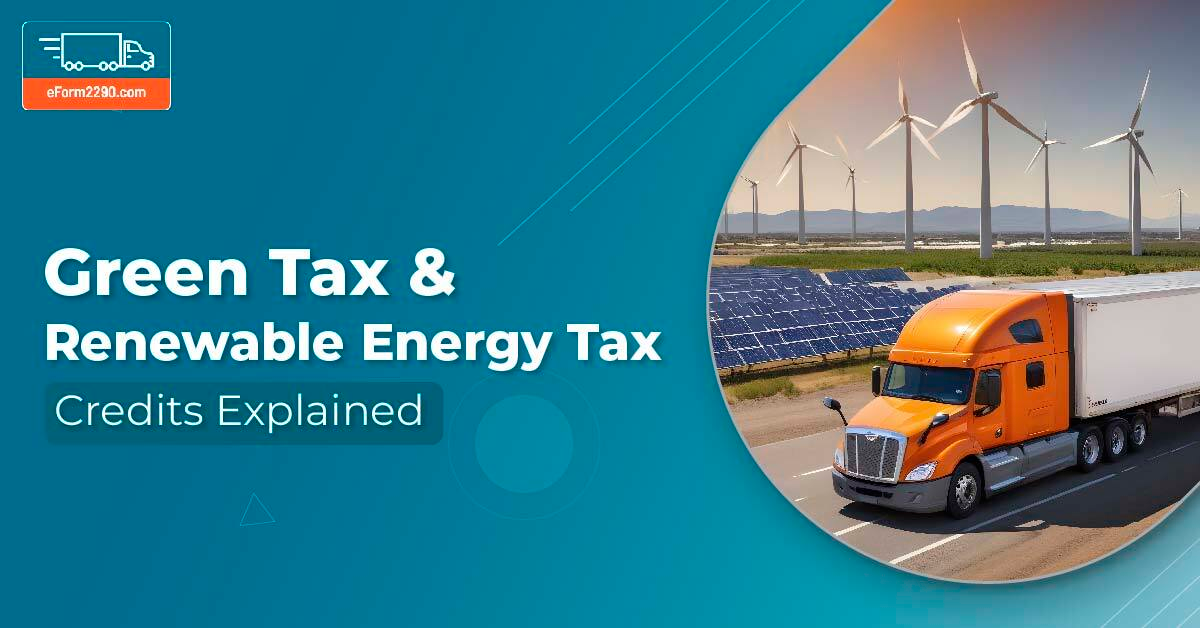The transportation industry plays a crucial role in the economy. It’s also an important part of the conversation about the environment. Old, inefficient vehicles and dirty fuels lead to increases in atmospheric pollutants and greenhouse gasses. But trucking professionals can be a critical driver of change by adopting and implementing sustainable practices in their businesses.
Governments around the world have encouraged (and in some cases required) eco-friendly updates through incentives and regulations. These typically take the form of renewable energy tax credits and green taxes. Let’s break these down to learn what they are and how they can benefit fleet owners.
What Are Renewable Energy Tax Credits?
Renewable energy tax credits, often referred to as green energy tax credits, are a federal incentive designed to encourage the adoption of renewable energy technologies, such as Solar, Wind and Biomass Energy. These credits provide substantial financial benefits to individuals and businesses that invest in renewable energy systems. For fleet owners, these tax credits can reduce operational costs while contributing to environmental sustainability.
There are two types of renewable energy tax credit:
Investment Tax Credit (ITC) — The ITC allows businesses, including fleet owners, to deduct a percentage of the cost of installing renewable energy systems from their federal taxes. For solar energy systems, the ITC can cover up to 26% of the installation costs, making it a highly attractive incentive.
Production Tax Credit (PTC) — The PTC provides a per-kilowatt-hour (kWh) tax credit for electricity generated by qualified renewable energy resources. This includes wind, biomass, and geothermal energy. The credit amount varies depending on the type of renewable energy used and the year the system was installed.
How Fleet Owners Can Utilize Renewable Energy Tax Credits
Taking advantage of renewable energy tax credits requires making changes to how your business operates. And not just small tweaks, but large, infrastructural updates to crucial components of your fleet. If you want to claim renewable energy tax credits, you need to consider these three updates:
Investing in Solar Energy — Fleet owners can install solar panels on their warehouses, maintenance shops, and office buildings. By harnessing solar power, they can significantly reduce their electricity bills. The ITC allows businesses to deduct a substantial portion of the installation cost, easing the burden of the initial investment.
Adopting Renewable Energy for Fleet Operations — If a fleet owner uses electric vehicles (EVs), installing solar-powered charging stations at fleet depots can provide a sustainable and cost-effective energy source for their EVs. This lowers fuel costs, and reduces the fleet's carbon footprint.
Leveraging Wind and Biomass Energy — For larger fleets with more significant energy needs, investing in wind turbines or biomass energy systems can be a viable option. The PTC provides ongoing financial benefits based on the amount of renewable energy produced, offering a long-term incentive for fleet owners to invest in these technologies.
Benefits of Renewable Energy Tax Credits for Fleet Owners
It might seem easier to stick with the way you do things. If it ain’t broke, why fix it? Plus change can be hard — and expensive. But renewable energy tax credits are designed to encourage making updates and investments in your business by providing short- and long-term incentives. Three of the biggest are:
Cost Savings — By reducing the upfront and operational costs associated with renewable energy systems, these tax credits make green energy solutions more affordable and financially viable for fleet owners.
Energy Independence — Utilizing renewable energy sources can reduce dependence on traditional fossil fuels, providing greater energy security and stability in the long run.
Sustainability — Investing in renewable energy helps fleet owners reduce their carbon footprint, contributing to environmental sustainability and enhancing their corporate social responsibility profile.
What are Green Taxes?
If incentives are carrots, then taxes are sticks. Green taxes, also known as environmental taxes or eco-taxes, are imposed by the government to account for the environmental impact of a business. These taxes encourage the adoption of greener technologies by placing a cost on having a large carbon footprint. While the primary objective is to generate revenue for environmental projects, it also serves as an incentive for businesses to upgrade to more eco-friendly vehicles.
The Goals of Green Taxes
No one likes taxes. But for lawmakers, they can serve as a way to change habits and behaviors while generating revenue to fund agencies and programs. Green taxes are no different. They are designed for two primary objectives:
Promote Sustainability — A critical goal of green taxes is to encourage companies, organizations, and sectors of the economy to embrace more environmentally-friendly procedures, reduce pollution, and preserve natural resources. Governments try to make ecologically hazardous items and activities less attractive by taxing them, while promoting alternatives (through incentives) that have less of an impact on the environment.
Earn Revenue — Changing behavior is just part of the intended outcome of green taxes. The government may also profit from them. The monies raised by green taxes are typically directed toward funding sustainable energy projects, environmental protection campaigns, or other initiatives that mitigate harm to the environment.
Understanding and utilizing renewable energy tax credits and green taxes is essential for anyone running a fleet operation. From significantly lowering operational costs to reducing carbon footprints to enhancing corporate reputations, these tools offer powerful incentives for fleet owners to invest in sustainable energy solutions. They can not only improve the efficiency of your business — they can future-proof your operation.
